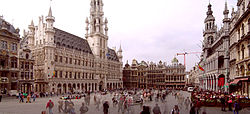Grand Place
| Grand-Place, Brussels | |
|---|---|
| Name as inscribed on the World Heritage List | |

The Grand Place; the Town Hall is at the left.
|
|
| Location | Belgium |
| Type | Cultural |
| Criteria | ii, iv |
| Reference | 857 |
| UNESCO region | Europe and North America |
| Inscription history | |
| Inscription | 1998 (22nd Session) |
The Grand Place (French, pronounced: [ɡʁɑ̃ plas]; also used in English) or Grote Markt (Dutch, pronounced [ˌɣroːtə ˈmɑrkt]) is the central square of Brussels. It is surrounded by opulent guildhalls and two larger edifices, the city's Town Hall, and the Breadhouse (French: Maison du Roi, Dutch: Broodhuis) building containing the Museum of the City of Brussels. The square is the most important tourist destination and most memorable landmark in Brussels. It measures 68 by 110 metres (223 by 361 ft), and it is a UNESCO World Heritage Site.
In the 10th century, Charles, Duke of Lower Lorraine constructed a fort on Saint-Géry Island, the furthest inland point at which the Senne river was still navigable. This was the seed of what would become Brussels. By the end of the 11th century, an open-air marketplace was set up on a dried-up marsh near the fort that was surrounded by sandbanks. The market was called the Nedermerckt, or Lower Market.
The market likely developed around the same time as the commercial development of Brussels. A document from 1174 mentions a lower market (Latin: forum inferius) not far from the port on the Senne river. The market was well situated along the Causeway (Dutch: Steenweg), an important commercial road which connected the prosperous regions of the Rhineland and the County of Flanders.
...
Wikipedia
